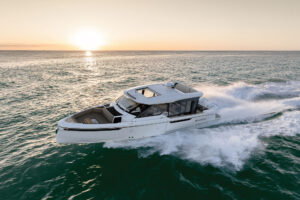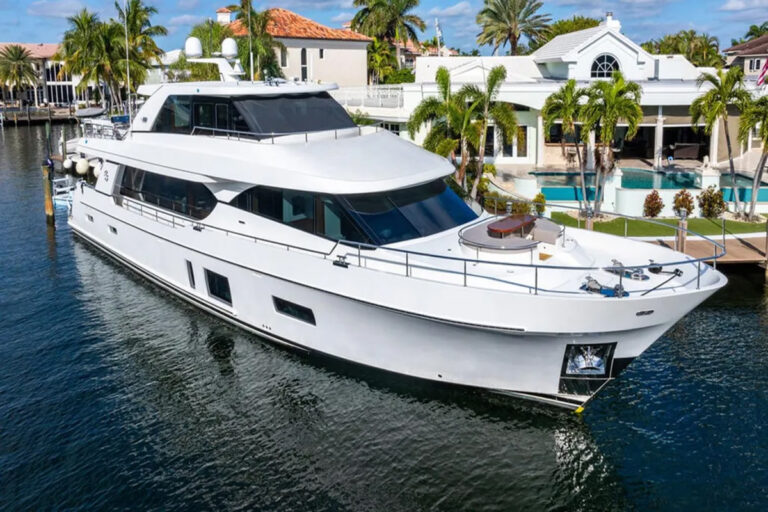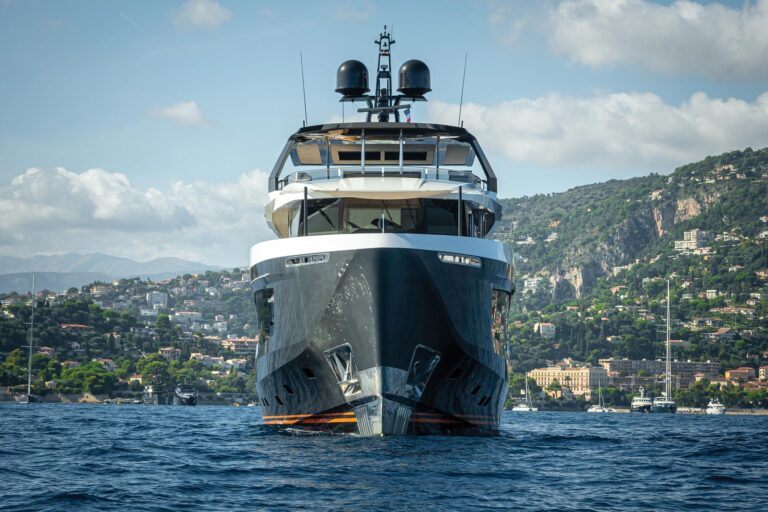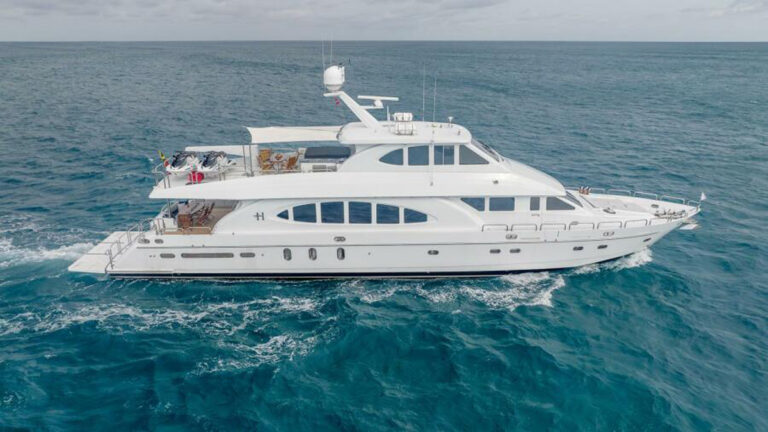Nothing strips away the unpleasantries of a world gone berserk like time aboard a boat. I’ve always believed living aboard would be the best tonic; lulled to sleep by gentle rocking and heaving, awakened by the cry of hungry gulls and stirred to action by the promise of adventure.
I’ve experienced hundreds of yachts that could functionally make the cut as second homes, but few have the special magic that says to me, “move aboard”. The 77-foot Lyman-Morse custom motoryacht Magpie does so in spades.
Beauty is pretty much a given with custom yachts. Soul is not. Soul derives from a happy convergence of the sensibilities the designer, the client and the builder bring to the project. Created by the Setzer Design Group of North Carolina, Magpie incorporates a subtle, beautiful S-curve in her sheerline, a low-rise superstructure, the suggestion of a clipper bow and a stunning tumblehome stern. Her interior styling and finish feel rich, almost organic. Magpie is one of the very few yachts I’ve seen in any genre that possesses beauty and soul.
When I entered the saloon, a few steps down from the bridge deck, I didn’t want to leave, so welcome the surroundings made me feel. The dinette, a great C-shape structure raised more than a foot above the cabin sole to provide standing headroom for the guest quarters beneath it, dominated the saloon. Smooth cushions and tufted seat backs in a hunter green faux leather, looking as though they’d been plucked from a 19th-century coach-and-four, invited me to sit, relax and have a glass of port.
An exquisite print sofa on the port side issued its own invitation-this time to stretch out with a captivating book and a nightcap, or maybe a must-see on the History Channel. This print is by no means subtle in its explosion of patterns, but the wonderful mix of muted shades-golds, blues, greens-radiates a peaceful glow. The carpet picks up many of the same colors, and I loved the compass rose motif in the center.
Mac Ferris, foreman of the cabinet shop at Lyman-Morse, is most responsible for the way Magpie‘s interior charms her visitors. He spent many hours selecting the wood for each cabin and labeling it so the grain patterns and natural shades would match or complement one another. Ferris also makes fine furniture for use ashore, and his sensitivity to the visual effect wood has on a room’s occupants shows in the way he scatters certain elements here and there. Where a simple wood panel would do the job, he added a raised panel to break up the mass. The wood front at the base of the sofa and the panels that define each end of the dinette are good examples.
The owner was worried about another visual effect altogether. During construction, he told Ferris he didn’t want to see any bungs or fasteners in the woodwork. Sandy Cochran, Magpie‘s project manager during construction and now her skipper, said this seemingly simple request cost the owner approximately $500,000 more in labor. The overhead, for example, is made from a series of marine plywood panels routed to resemble tongue-and-groove assemblies. The mullions that separate these removable panels have to clip into place with male/female fasteners hidden on the underside.
Massive wood structures, especially ones made of relatively dark mahogany, can overwhelm a small space-shrink its size visually. Handrails, banisters (vertical spokes) and newel posts often are far too heavy-handed. George Davies, one of the star woodworkers under Ferris’ management, turned the most delicate banisters I have seen on a boat. Capped by equally elegant hand-carved rails and vertical motif newel posts at the lower terminus of the companionways, these handrail assemblies seem to add volume to the areas they serve.
A U-turn to starboard from the bottom of the companionway stairs took me to the master stateroom. Excellent lighting combined with a white overhead, white panels in way of the large portlights, and a carpet of soft neutral color to create a cozy, but not gloomy, atmosphere. Imagine waking at sunrise and taking your first coffee on a sun-drenched cockpit. Simply summon the steward, then climb the three steps of your private companionway and take a seat in the cockpit.
I found nothing extraordinary about the galley until I poked around for a few minutes. The layout is simple and efficient-counters on three sides, broken up by a sink along the topsides and a four-burner electric range inboard at the end of the forward counter. Granite veneer over a core of aluminum honeycomb forms the countertops. Light from overhead lamps and portlights in the topsides let the chef see exactly what he’s adding to the sauce. A tall refrigerator/freezer occupies the space adjacent to and right forward of the stove. Stowage cupboards line the area outboard of the counters; drawers fill the cavities below.
Some of the more impressive elements of Magpie‘s interior appeared when I stood in the passageway forward of the galley and looked aft. A counter on the starboard side hides the dishwasher. Three doors in the base of the dinette conceal slotted stowage for the crystal. Above, at the after end of the galley, an elegant curved molding defines the area’s extremity. It also echoes the curvature in the base of the dinette and the line described by the windows in the fascia of the saloon. This is a simple element, but it’s lovely to see and it opens the galley to light from the saloon.
By now, the 1,300 hp MAN diesels were ready to go. These massive devices spin 34-inch props via ZF gears and V-drives. The V-drives put the horsepower and noise as far aft as you can get without tossing the engines overboard. The genset, air-conditioning compressor and more are beneath the saloon and are muffled to a whisper. The propulsion engines, too, are quiet until the turbos kick into full song. Cochran said the sound experts were looking for a way to hush the turbos. They succeeded, based on my experience.
Magpie is remarkably maneuverable for a 77-foot boat. She responds to her bow thruster as though she were half her length, and the huge torque from the MANs coupled to big wheels gives her instant thrust when you disengage the trolling valves. As long as the wind isn’t blowing half a gale, she’ll go where you command her to go.
Idle speed without the trolling valves gave us nearly 10 knots on the GPS, but her wake remained quite low and gentle. That’s a function of her volume distribution below the waterline. After we cleared the “no wake zone, Cochran opened the throttles to 1800 rpm. Magpie‘s rate of acceleration surprised me. Her light weight is the key.
We headed east by north-upwind according to the Ockam display. Seas ran 2 to 3 feet. We accelerated to a maximum speed of 32 knots, at which point the engines became a little rowdy. The clear vinyl enclosure at the after end of the bridge deck was surprisingly effective at rejecting noise from the exhaust and turbo, but Magpie needs more effort at sound attenuation. At a cruising rpm of 1600, she quiets right down. A solid structure in place of the canvas/vinyl curtain would surely provide all the muffling she needs.
I took the wheel for the run down to Miami. Magpie treats the helmsman like an honored guest. Her assisted steering is light and positive, though I would prefer a quicker ratio. The Glendinning electronic controls were smooth and had nicely weighted detents. The lines of sight from the helm through 360 degrees were excellent, which had the effect of shrinking the boat. At all speeds, she felt solid and comfortable in these moderate seas. Cochran said Magpie can maintain her cruising speed as the seas grow to 6 feet or better. She doesn’t pound or toss occupants about the accommodations like rag dolls in a clothes dryer.
I stole a last look at Magpie after disembarking in Ft. Lauderdale. I could still feel the beat of her big MANs, and I knew I would miss the way she shouldered aside waves and coddled me with human touches. If ever I find a way to fulfill my dream of living afloat, I hope I find a yacht like Magpie.
Contact: Lyman-Morse Boatbuilding, (207) 354-6904; fax (207) 354-8176; jb@lymanmorse.com; www.lymanmorse.com.









